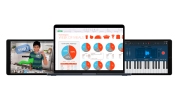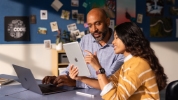Get updates from Apple Education.
Have you signed up for Apple Education emails? You’ll get more stories like this featuring school leaders solving challenges with Apple technology, plus updates on Apple products, programmes, events and more.

Empowered teaching uplifts educators and students alike. When teachers know how to use the latest technology and tools, they can adapt to the rapidly changing needs of students. Apple spoke with two education leaders about their strategies for effective professional learning through active leadership involvement.
Developing quality teachers leads to developing quality learners.
Learn how Prawit Srinongwa, Deputy Director at Panyapiwat Institute of Management Demonstration School in Thailand, creates a culture of continuous learning and sharing between teachers and leadership.
The way we teach should be intrinsically related to how we want people to learn.
Learn how Michael Mills, Associate Dean of the College of Education at the University of Central Arkansas, explores how creating environments of non‑judgement can encourage teachers to start using technology in transformative ways to meet student needs.



Have you signed up for Apple Education emails? You’ll get more stories like this featuring school leaders solving challenges with Apple technology, plus updates on Apple products, programmes, events and more.
Empower educators to learn, create and define their own success with Apple technology.
Apple and EducationShare this page and help others discover the Apple Education Community.
A link to this page in the Learning Center has been copied to your clipboard.
Deputy Director, Panyapiwat Institute of Management Demonstration School
Thailand
My name is Prawit Srinongwa, Deputy Director at Panyapiwat Institute of Management Demonstration School in Thailand (Satit PIM). Our school aims to nurture the next generation of children by instilling a sense of civic responsibility and focusing on their individual interests. We believe teachers play a key role in helping us reach our student success goals. Our strategy is to heavily invest in the development of our teachers so they’re prepared to model and inspire students to be lifelong learners.
Students in today’s world are quick learners and have access to so much information. Teachers need to keep pace with their progress by using technology and tools to guide students in discovering their own potential. We want teachers to create an environment of active learning where students aren’t just memorising content, but engaging in their assignments and learning from direct experiences. Our school chose to have teachers and students use iPad because it’s a powerful, accessible tool for this active learning environment.
We encourage teachers to transition from instructing to facilitating and coaching students in acquiring skills and knowledge.
We encourage teachers to transition from instructing to facilitating and coaching students in acquiring skills and knowledge.
Ever since our school opened six years ago, we’ve made a conscious decision to focus on developing our teachers. We have a Professional Learning Community that prioritises four main components in supporting educators: Sharing Teaching Techniques, Observing and Discussing Student Behaviour, Soft Skill Development and Technology Up‑Skilling. In the Technology Up‑Skilling component, the first step required of all our teachers was to become Apple Teacher recognised. The Apple Teacher programme is a foundation to our professional learning and helps teachers gain skills on iPad. We also hired an Apple Professional Learning Specialist (APLS) who works in person with our teachers to mentor them in improving their digital skills.
When it comes to the Sharing Teaching Techniques component, we run teaching showcase sessions once a month. Consistency is important here. In the sessions, teachers have opportunities to share with their colleagues their innovative teaching techniques and how they apply technology in the classroom. As the leadership team, we make sure that we attend and provide direct positive feedback to acknowledge our teachers’ work. Teachers of every subject have an opportunity to demo while fellow teachers, especially new ones, can leverage their ideas and materials.
Education is all about sharing, and everyone benefits from sharing practices like this. We aim to be a role model for the country, so we also encourage teachers to share their techniques in visits to other schools and external organisations. Ultimately, we want to help transform the Thai education system by sharing our practices with other schools. This culture of sharing is empowering for everyone.
As the leadership team, we need to make sure we are steadily communicating our vision while also ensuring our teachers feel recognised for their contributions. We need to know our teachers’ capabilities and expertise, so we conduct sessions where our leadership team observes and supports teachers in the classrooms. At the end of each term, our executives revisit the classrooms to assess progress and identify areas of further growth. It’s our job to encourage teachers to unleash their potential. And when we observe that they’re doing inspirational things, we should find a stage for them to share their teaching experiences. For example, an exceptional project was from one of our Chinese language teachers, who asked students to write a script in Chinese and then use their Apple Memoji to narrate it in a video on iPad. We asked her to present this in a Sharing Teaching Techniques session and she provided example assignments of students having fun creating their video skits.
It’s also leadership’s responsibility to make sure teachers can continuously learn the latest technology and new teaching methods. We work very closely with our contracted Apple Professional Learning Specialist (APLS) to do this. Our APLS technology expert is integrated into our school and helps us assess and plan the curriculum. We bring in other external subject matter experts to help guide teachers on learning new software or designing new curricula. We go the extra mile with these external experts because we want our teachers to know best practices and to be leaders in using technology.
Our school’s focus on professional learning has clearly paid off for students: our initial generation of students has now graduated, and the entrance rate of our students to higher education is exceptionally high for schools in Thailand. We’re especially proud that our students were admitted to a diverse range of prestigious universities in fields like medicine, engineering and architecture.
Consistently ensure that leaders, teachers, students and parents are on the same team and are working towards the goal of student development. Communication and creating mutual understanding are so important.
If we treat the school as one community, each and every one of us – leaders, teachers, students – feels like we have a responsibility to uphold.
If we treat the school as one community, each and every one of us – leaders, teachers, students – feels like we have a responsibility to uphold.
School leadership can sometimes just focus on higher urgency problems. But I look at my job as being an active leader for teachers in the school. The leadership team establishes clear policies and objectives for teachers and gets involved throughout the entire development process. We go into the classrooms, we attend the sharing sessions, and therefore we can be timely in supporting teachers who are facing challenges. Active leadership involvement encourages all the teachers and reinforces a sense of collective effort in the school.
Associate Dean, University of Central Arkansas College of Education
Arkansas, United States
I’m Michael Mills, the Associate Dean of the College of Education at the University of Central Arkansas. I’ve been working on teacher education with the university for 12 years, but before that I was a full‑time teacher, so I have perspectives as both a leader and a teacher.
Our university started off as a teacher’s college, so we have teaching in our DNA. A big part of our vision is technology innovation as the vast majority of our programmes are online. Back in 2016, we were looking for technology that could support a paedagogical shift to more interactive learning and student voice, and iPad gave us that. I coordinated the college’s mobile learning one-to-one initiative where every student and staff member had an iPad.
When we implemented one-to-one devices, we made sure that the place of learning offered psychological safety as teachers and students learnt new technology. Think about psychological safety like productive failure. Let your teachers and students have a space where they know that they can fail, iterate and have ideas that may not go anywhere.
Teachers often want to control the classroom for their students in the same way their teachers did for them growing up. So when you introduce iPad, it creates this X‑factor where teachers can’t predict the outcome at the end of the class. Most of the time, our staff were less scared of the leadership team’s judgement and more scared of their students’ judgement. We as leaders need to meet these fears with encouragement and tell them, “If it fails, that’s fine! Keep trying. Your students will appreciate when you put yourself out there.”
We want to make sure our classrooms and our students’ future classrooms have room to experience failure and growth. I remember one staff member indicated she may be open to trying something new. I showed her some apps on iPad, but also encouraged her to explore on her own. The apps she ended up trying were low-hanging fruit, but I didn’t show her any judgement. Every chance I got, I would tell her it’s so awesome that she’s sticking with it. Just this past term, she told me she started having students create interactive books using Pages on iPad. The fact that she designed a creative assignment on her own to help her students think critically was a huge win.
What I have come to realise in my 29 years of teaching is that if you shut down all institutions of higher education, people will still learn what they want to learn. We now live in a digital world with the ability to connect to anyone. In education, we don’t need someone standing in front of us all the time to tell us facts and information. We need someone to give us context and purpose. We, as formal teachers and education leaders, either need to be more engaging and better paedagogical deliverers or we’re irrelevant. And that’s a fine thing because all that really matters is that students get to learn what they need to learn to be successful.
The way we teach should be intrinsically related to how we want people to learn.
The way we teach should be intrinsically related to how we want people to learn.
To me, empowered teaching means making assignments more creative to allow for student voice. What’s being measured should be clear, but give students a suite of open‑ended choices of what they can hand in: a video, an interactive book, a podcast. In an ideal situation, the student doesn’t look at the options and ask, “Which one is the easiest? Which one can ChatGPT help me do?” But instead, “How do I want to express myself?” I had a staff member from another college complain about ChatGPT and I told him, “Well, quit asking for essays!” If I tell students to write essays all the time, who would blame them for going to ChatGPT?

Three out of four teachers agree that students learn most when they can creatively express what they know.
Three out of four teachers agree that students learn most when they can creatively express what they know.*I am very proud of one of our staff members who teaches a classroom assessment course, and, in the class, the instructor has students using Pages and Keynote to create and pitch five different assessment types. We noticed that as students moved away from traditional multiple choice tests, they started designing more process‑oriented assessments using iPad. They are more creative, using more images, and they want their students to be engaged in a discussion or brainstorming.
We want students to learn quickly, but also take the time to be inclusive in reaching an audience. When you give students technology, you start to see them not only innovate, but also open up and express their commitment to equity and inclusion as well. iPad and Mac were easy and powerful for them to use to this end. Pick up your iPad, and you can create an annotated video and provide captions for people who are hard of hearing. They’re incorporating inclusion from the start.
The bottom line for me is getting away from traditional assessment. We need video. We need creation. We need student voice. The only way to have creative assessments is by using some type of creative outlet, and that’s why I love that we have iPad.
I would tell a school leader to first assess how much your students are actually getting out of their classroom experience. Are all students being assessed according to their needs? Not all students perform well on a multiple choice test. Some students prefer to be interviewed or draw or create a video. This is a mind shift for teachers. There is no easy button for this. It takes time because teachers have to grapple with discomfort. In many ways, it is disheartening at first – I felt this too – to realise they aren’t educating all of their students equally.
Leaders need to research setting up environments for productive failure and psychological safety. Instead of telling teachers they’re wrong, consider saying, “What you’re doing right now is amazing. And what if you did one small thing that would expand your audience? What if you added annotations or captions here?”
So the first baby step is research and honest conversations with teachers. After that, teachers can give students more opportunities to share their voice and be authentic. And then we can all start to recognise what true authenticity is in learning.
* Source: Creativity in Learning. The Creativity in Learning report was developed by Gallup, based on funding provided by Apple Inc. The findings and conclusions are those of Gallup.